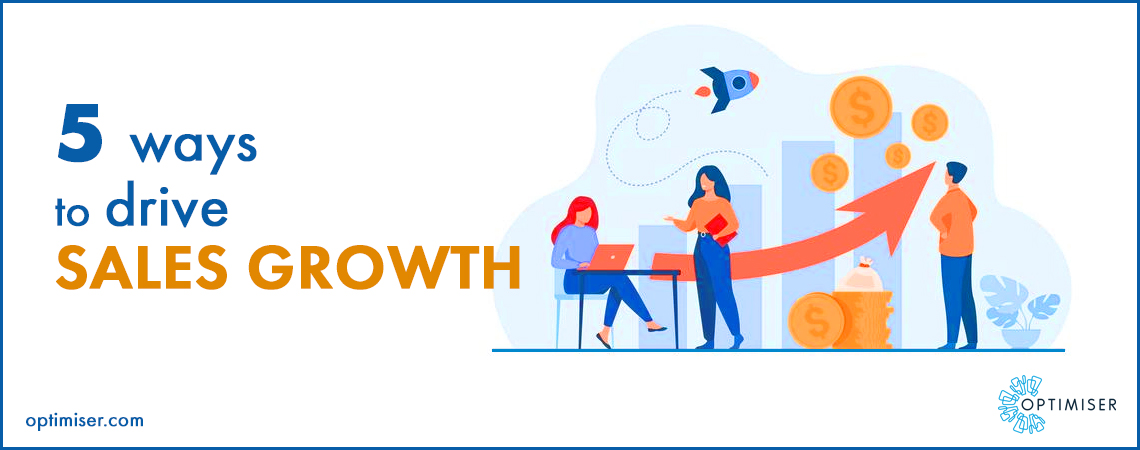
CRM for Sales
Five ways to drive sales growth
Why you should be keeping a steady sales strategy
Focus on your existing customers
Leverage an integrated sales tool
Why you should re-evaluate your current sales tools
Driving sales growth should be at the forefront of any business’s considerations looking to bounce back from the difficulties of 2020. Developing a holistic sales strategy that prioritises reducing outgoing time and financial resources, while building a stronger pipeline and nurturing existing customers is the best way to do so.
Why you should be keeping a steady sales strategy
We currently face one of the biggest economic declines in history due to the tumultuous year for business between March of 2020 and 2021. More than ever, businesses need to find out ways in which they can do more with less: drive potentially company-saving sales while limiting outgoing expenditure.
Strict freezes on hiring and spending is one of the ways companies have decided to go about preventing or slowing down rapidly declining revenue streams, but sales concerns remain a considerable opportunity for businesses to either gain back or lose further. To generate more sales with fewer resources, your priorities should be:
- Risk management
- Increased efficiency and productivity
- Driving revenue
Ruthless prioritisation of what is important to your healthy and lucrative business function is essential. By pinning focus on doing fewer, more successful things: the best markets, reps and accounts, you enable your teams to do more with less.
By obtaining the best digital tools that enable you to focus on your new online sales strategy, retraining reps in the new environment and developing a strong recovery plan, your business can thrive in this next era of the world’s global marketplace.
1- Focus on your existing customers
Find a way that allows your teams to accurately qualify prospects. Based on this information, teams should then rescore accounts based on who has the most potential, determine high-priority clients and detect resource gaps. By doing so, you allow limited resources to be deployed on accounts and contacts that are the most likely to be a good return on investment (ROI).
2- Develop a new strategy
Once you’ve determined which are your most valuable accounts to be chasing at the current moment, it’s up to your sales teams to use their resources to develop a new strategy that targets the new consumer priorities in 2021:
- Stability: is your company stable and reliable enough to continue providing excellent products/ services in the face of a rapidly evolving marketplace?
- Value: much like you, your clients will be looking to reduce spending and increase productivity. What can your company offer consumers in terms of value that others cannot?
- Presence: customers have come to expect to be able to connect with brands when and where they want to. Are you operating an omnichannel sales service with expanded opening hours that assures clients they can receive support at any given time?
Make sure that with every communication, these values are at the core of your messaging:
.jpg)
3- Prioritise customer service
Businesses across the world have discovered that building relationships in the new digital workplace is far more difficult than in person. Make sure your customer service focus prioritises a new strategy for phone calls and web meetings that teaches sales reps how to emote and connect without the typical face-to-face factors. This new customer service strategy should also incorporate clear and personalised email communication!
4- Leverage an integrated sales tool
Sales tools are a great way to track the progress and performance of both individual accounts as well as sales as a whole. Not only can a powerful sales suite evaluate the probability of your accounts for you, it can optimise the way you create relationships with your high-priority clients and automate those time-consuming processes that can create a large drain on your productivity.
The integrated nature of your chosen sales tool is vital, as it helps your reps to contextualise their sales data, relative to the performance of other departments: including marketing, service and finance.
Why you should re-evaluate your current sales software tools
Your digital sales tools are the first step to driving sales growth through productivity and automations. Used correctly, they can optimise long-standing business systems and processes as a relatively inexpensive piece of software with multiplicity of function.
- Manage business risk by accurately recording, analysing and forecasting market trends
- Personalise sales relationships with detailed contact and account profiles
- Automate time consuming tasks to increase productivity
To ensure each of your sales tools is worth its value in expenditure, the three following steps should help you discern how to move forward with your digital sales process.
1- Outline each tool involved in your current sales process
If there are more than one, what tools does your business currently use? What are its exact properties and functions? Where does it sit within your business scope, and which teams use it?
2- Determine the value / use of each tool
How much use do your teams get out of each tool, and could they function the same way without it? How much do you pay for your subscription, and how much value in revenue can you clearly attribute to the function of that particular tool? Make sure you can highlight your most useful tools, as well as the least.
3- Create a roadmap to sunset those tools that carry the least value
When you’ve determined which tools you will be getting rid of due to lack of use, lack of value, or lack of necessity, create a roadmap to phase it out of your business process. In some instances, you may be able to shift functionality onto a different tool- but how long will this take? Be sure to incorporate time for onboarding or retraining into your roadmap.
How Optimiser can help
Optimiser’s fully-integrated software suites allow users to customise their subscription to meet the exact needs of their business or industry, cutting costs on unused or unnecessary tools. Each subscription to the CRM comes with Pipeline, Contacts and Accounts, Calendar and Analytics as a standard, meaning personalising relationships with customers gets a whole lot easier. Integrated sales and marketing suites ensure that your sales growth strategies stay customer-focussed and relevant, resulting in bigger successes and happier consumers.
Optimiser is a comprehensive CRM software company, providing businesses a customisable solution to their personal goals for sales, productivity, and growth. Powerful integrated modules include lead management software, a B2B sales toolkit, automated marketing suite and more for sale under a single subscription. Try Optimiser’s CRM software demo with access to the full Enterprise Licence FREE for 30 days, and find out how you can skyrocket productivity in just one month!

30 days free trial. No credit card required
 One powerful platform
One powerful platform
 Simple to use
Simple to use
 Comprehensive
Comprehensive



